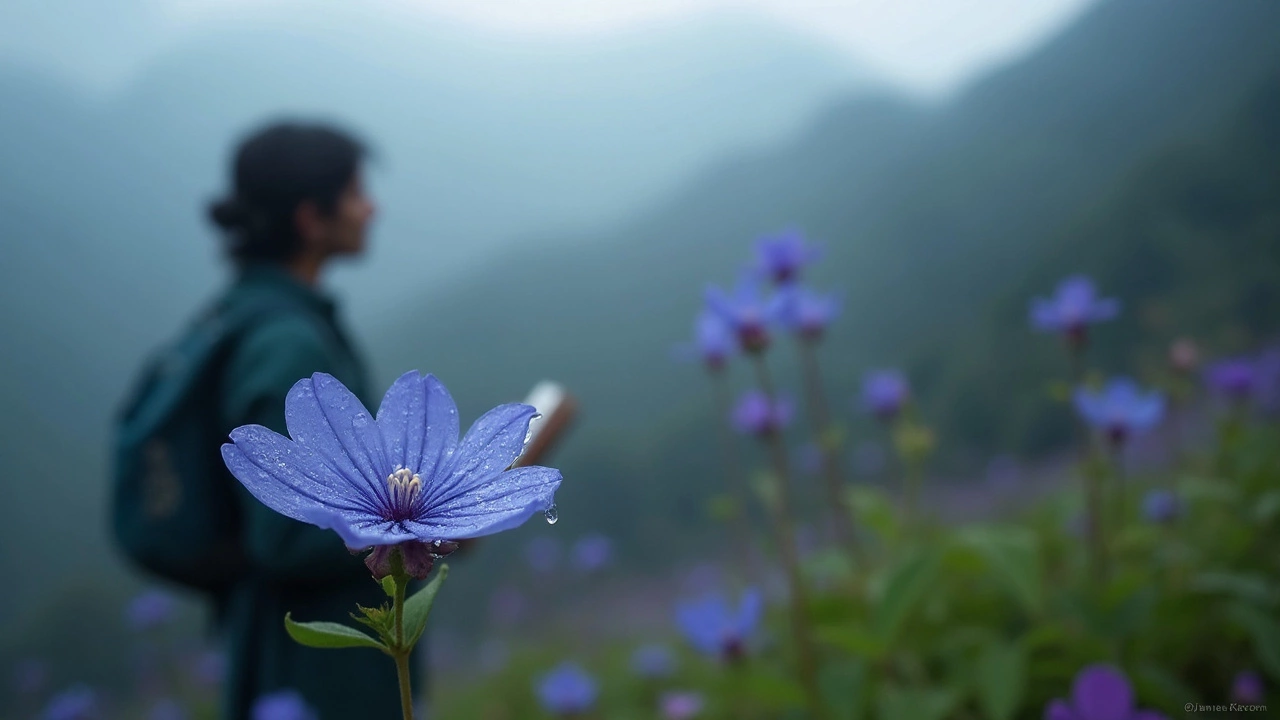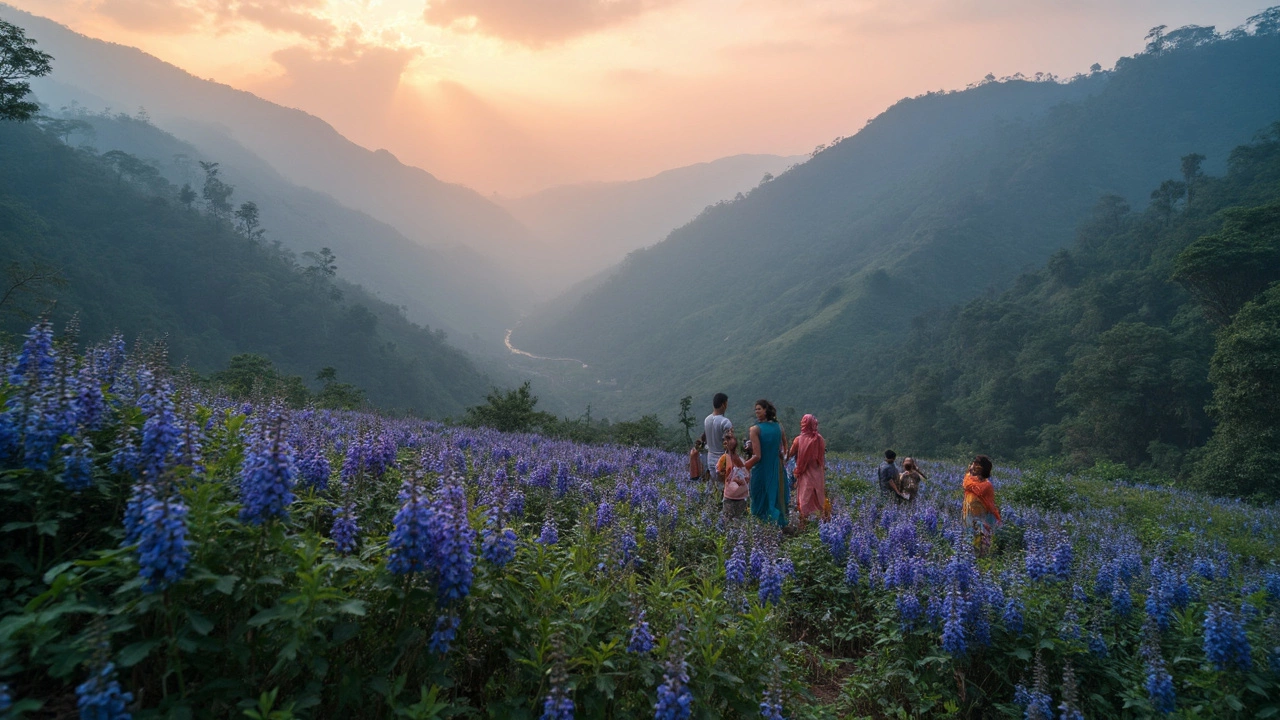If you want to talk about rare plants in India, nothing tops the Neelakurinji. This isn’t just another flower—it's a real spectacle that grabs headlines across the country every time it blooms. And here’s the kicker: you might wait over a decade for that chance, since the Neelakurinji only bursts into color every 12 years. People have planned vacations years in advance just to catch this fleeting show.
Seeing these hillsides in the Western Ghats suddenly turn blue is something you’ll never forget. But with climate change, tourism, and habitat loss creeping in, catching a glimpse is getting harder. Locals in Kerala and Tamil Nadu treat that short season like a festival. If you ever thought about chasing rare blooms, knowing when and where to look is half the trick. Protection efforts matter now more than ever—because once you lose something this rare, there’s no coming back.
- What Makes a Plant ‘Rare’?
- Meet Neelakurinji: India’s 12-Year Wonder
- Where Can You See Neelakurinji?
- Why Is It so Rare and Endangered?
- Tips if You Want to Witness the Bloom Yourself
- Saving Rare Plants: What’s Happening in India?
What Makes a Plant ‘Rare’?
When you hear about a "rare" plant, it’s more than just a label. For scientists and plant lovers, a plant is considered rare when it has a super limited natural range or population, usually because of environmental factors, human activity, or just freaky biology. Some grow in only a single location, while others are hard to spot because they bloom for a short time or need exact conditions to survive.
There are official ways to define rarity. The International Union for Conservation of Nature (IUCN) lists species as vulnerable, endangered, or critically endangered, depending on just how close they are to disappearing. In simple words: if a plant species drops below a safe population or spreads over a tiny area, it’s earmarked as rare.
- Plants growing only in one region or mountain range
- Species with less than 250 mature individuals left (IUCN data)
- Plants whose habitat is nearly destroyed or shrinking fast
- Those needing a certain animal, soil, or weather to even grow
Here’s an example from the field. According to a botany professor in Kerala:
“A rare plant is not just about low numbers—sometimes, even a species with a few thousand members is rare if it’s only found in one place. If that spot is lost, so is the plant,” says Dr. Madhavan Pillai from M. S. Swaminathan Research Foundation.
Let’s break down some numbers to give it context:
| Definition | Numbers or Range |
|---|---|
| IUCN ‘Critically Endangered’ | Fewer than 50 mature individuals globally |
| Endemic Plants | Exist only in one region or state |
| Rare Seasonal Plants | Bloom/appear only for a few weeks in a decade |
In India, what’s considered a rare plant india is usually one that’s linked to the changing seasons or a specific ecosystem like the Western Ghats or northeast hills. And sadly, many of these plants are also on the edge because of deforestation and changing land use. Spotting one in the wild feels like a small win these days.
Meet Neelakurinji: India’s 12-Year Wonder
The Neelakurinji, or Strobilanthes kunthiana, doesn’t play by the usual plant rules. It’s not found in every garden or park—you can only spot this plant in a few places, mostly on the shola grasslands of the Western Ghats in South India. Here’s the wild part: the whole population of Neelakurinji in an area blooms together, and this happens just once every 12 years.
This timing isn’t some random deal. Scientists figured out that the plant’s life cycle is built entirely around this rare event. It spends over a decade just growing as a shrubby green mass. Then, almost like someone flipped a switch, millions of these plants suddenly cover the hills in blue and purple blooms. After the flowers vanish, every plant dies, leaving seeds behind for the next generation—so you’re basically watching a once-in-a-lifetime floral reboot.
Why does this bizarre cycle even exist? It’s thought to give these plants an edge. Because every Neelakurinji blooms at once, it’s harder for predators or bad weather to ruin all the seeds. Plus, it turns the attention of bees, birds, and humans toward pollinating and spreading seeds at the right moment. There are over 40 species of kurinji, but only this one, the most famous rare plant india has this notorious 12-year cycle.
Neelakurinji is native to altitudes between 1,300 and 2,400 meters. So if you’re out for a trek in places like Munnar or the Nilgiris during the flowering season, prepare to see entire hillsides look like they’ve been covered in a blue blanket. Locals even use the bloom to count their age, jokingly asking, “How many kurinjis have you seen?” It’s that legendary.
Where Can You See Neelakurinji?
If you want to hunt for the Neelakurinji, you need to aim for the hills in southern India. Your best bet is the Western Ghats, especially the hills around Munnar in Kerala. When this plant blooms, Munnar’s slopes turn bright blue and pull in a ton of folks from all over the country.
It’s not just Munnar, though. Kodaikanal in Tamil Nadu also gets the Neelakurinji bloom, usually in the Shola forests nearby. The Nilgiri Hills sometimes get a few patches, but the main action happens in Kerala and Tamil Nadu.
- Munnar, Kerala: The most famous and accessible spot. You’ll find Neelakurinji all over places like Eravikulam National Park and Rajamala.
- Kodaikanal, Tamil Nadu: Look for it along the higher ridges and forest patches around this hill station.
- Nilgiri Hills: A few scattered pockets, but much harder to spot here. The bloom isn’t as intense as Munnar’s.
Don’t expect to find Neelakurinji just anywhere, even in these areas. They’re picky about where they grow. Neelakurinji usually pops up between 1,300 and 2,400 meters above sea level, sticking to rocky grasslands or open slopes.
| Location | State | Bloom Years |
|---|---|---|
| Munnar (Eravikulam National Park) | Kerala | 1994, 2006, 2018, 2030 (next expected) |
| Kodaikanal Hills | Tamil Nadu | 2006, 2018, 2030 (next expected) |
| Nilgiri Hills | Tamil Nadu | Patchy, unpredictable |
Here’s a pro tip: plan ahead if you want to catch the next bloom. The last big bloom was in 2018. The next one’s coming up in 2030, so set a reminder! During a big season, towns like Munnar get really crowded, so it pays to book travel and hotels as early as you can. And bring a camera—Neelakurinji doesn’t show off often.

Why Is It so Rare and Endangered?
Neelakurinji is rare because of its unusual blooming cycle—once every twelve years. That's not a typo. This long gap means the plant spends most of its life as a simple bush, blending into the hillside. It only steals the spotlight for a few weeks after more than a decade. If anything interrupts its cycle, the chances for new seeds drop sharply.
But that's just the start. The Western Ghats—where Neelakurinji calls home—are losing ground. Roads, development projects, and unplanned tourism are eating up the natural habitat. When forests turn into tea plantations or tourist resorts, Neelakurinji just can't compete. In fact, about 40% of its original habitat has been lost in the last fifty years.
The impact of climate change also can't be ignored. Warmer temperatures and shifting rain patterns throw off the plant's rhythm. Sometimes, patches flower out of sync or even skip a season. Without a healthy burst of flowers, there's no big crop of seeds, so new plants become even rarer.
- Neelakurinji grows only at specific altitudes, usually between 1300 and 2400 meters, making it even fussier about where it thrives.
- Grazing by cattle and invasive weed growth plow through the young bushes before they can mature.
- Picking or trampling the flowers—often for social media photos—puts extra stress on the already limited population.
| Reason | Impact on Neelakurinji |
|---|---|
| Loss of habitat | Fewer places for plants to grow |
| Climate change | Irregular blooming, less seed production |
| Tourism | Trampling and illegal picking kills plants |
| Grazing/Invasive Species | Young plants destroyed before maturing |
This is why rare plant india isn't just a search term—it's a situation that's alarmingly real for Neelakurinji. Without more careful protection, getting to see this blue wonder in person could soon become just a story.
Tips if You Want to Witness the Bloom Yourself
Catching the Neelakurinji bloom is not your average plant hunt. The most important thing to nail down is your timing. The last big bloom was in 2018, so the next one is expected around 2030. Don’t just show up and hope for the best—planning is key.
- Best Time to Visit: Neelakurinji generally blooms from July to October, but peak bloom (when almost every bush is loaded with blue) is usually September. Check for local news and Kerala Tourism advisories each season, as exact peak weeks can shift with weather patterns.
- Where To Go: Your best bet is Munnar in Kerala, especially the Eravikulam National Park. Other hotspots are Kodaikanal and Ooty in Tamil Nadu. These places go all out during bloom years, sometimes even restricting visitor numbers to protect the hills.
- Permits & Tickets: During high bloom years, Eravikulam National Park uses timed entry passes to manage crowds. Always book online early. Tickets can sell out weeks ahead, and you definitely don’t want to travel all that way and get stuck outside the gate.
- What to Pack: Good walking shoes (it’s hilly), a rain jacket (showers are common), water, and a basic first aid kit. Drones are banned in most protected areas.
- Respect the Plant: This might sound obvious, but don’t pick or trample the flowers. Stay on marked trails—the park rangers can get strict about this, and for good reason.
- Plan for the Crowd: The Neelakurinji attracts thousands. Be ready for jams on the way to Munnar, long lines for buses into the park, and a festival-like buzz at local eateries and hotels.
If you’re after the full rare plant india experience, check the weather. Too much rain and the trail gets muddy, not enough and the bloom can be patchy. Locals swear that the panoramic spots like Rajamala and Top Station offer the best selfies and views.
| Spot | State | Best Viewing Month | Entry Requirements |
|---|---|---|---|
| Eravikulam National Park (Munnar) | Kerala | September | Online ticket, ID proof |
| Kodaikanal Hills | Tamil Nadu | August–September | Basic permit |
| Ooty (Nilgiris) | Tamil Nadu | September–October | No permit, but travel advisory |
The bottom line? A little extra planning goes a long way. If you want to see Neelakurinji in its prime, time your visit right, prep your gear, and don’t leave bookings to the last minute.
Saving Rare Plants: What’s Happening in India?
India’s got a wild range of rare plants, but honestly, saving them hasn’t always been a top priority. Things are shifting, though. Now there’s more buzz around plant conservation, especially since folks realize that unique species—like the Neelakurinji—are vanishing right in front of us.
Government bodies, local groups, and scientists are stepping up. The Botanical Survey of India keeps an official list of threatened plants and collects data on what’s at risk. For hotspots like the Western Ghats, where many rare plants grow, some areas have been tagged as protected. That means fewer buildings popping up and stricter rules about plucking, grazing, or even trekking through certain patches when sensitive plants are flowering.
Some states, like Kerala, set up special “bloom-watch” campaigns. These tell locals and tourists how to enjoy the show without damaging anything. Legal fines are real—a few years back, picking Neelakurinji or trampling it could land you with a ₹25,000 penalty.
Researchers are also trying what’s called “ex-situ conservation”—basically growing rare stuff outside its natural home, in botanical gardens or labs, as a back-up plan. The Indian Institute of Science in Bangalore even managed to grow Neelakurinji in lab conditions, just in case the wild ones get wiped out. But most experts say keeping plants thriving in the wild is way better for the ecosystem than growing them behind fences.
| Rare Plant | Main Threat | Protected Area | Bloom Cycle |
|---|---|---|---|
| Neelakurinji | Habitat loss, tourism | Eravikulam National Park | 12 years |
| Pitcher Plant (Meghalaya) | Illegal collection | Baghmara Reserve Forest | Irregular |
| Blue Vanda Orchid | Smuggling | Namdapha National Park | Yearly |
Thinking of helping out? Experts suggest not picking or stepping on wildflowers, joining local awareness events, and if you travel somewhere special, sticking to marked paths. Simple steps, but they help keep future generations from just hearing stories about blooms they’ll never see.

